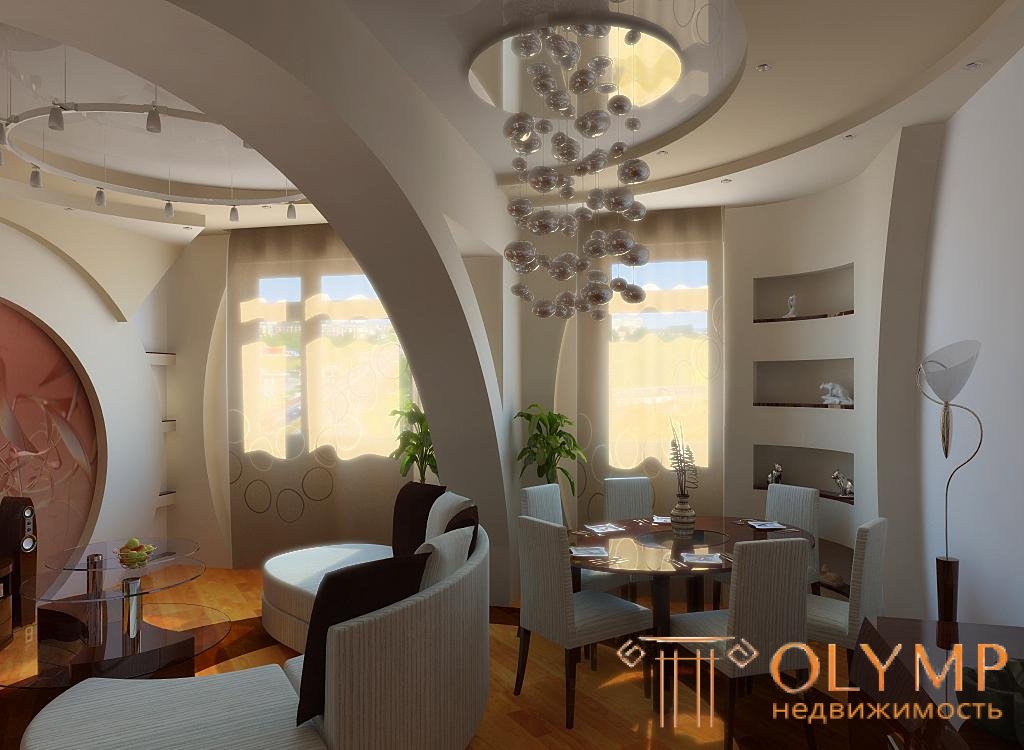
Versatile, practical and inexpensive drywall is used when finishing the apartment not only by professionals, but also by beginners in construction and repair. This material has received high popularity precisely because of the wide possibilities of its use. Not all builders are aware of some of these opportunities. As you know, GCR is based on gypsum, but it can be bent. With knowledge of how to bend drywall, you can easily make a curved partition, arch, or a beautiful multi-level ceiling.
Content:
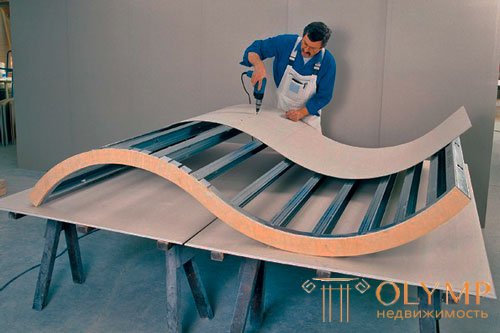
The flexibility of drywall depends on its thickness.
Depending on what kind of bend is needed in a certain situation, different types of sheets are used. Therefore it is necessary to deal with the varieties of drywall that are most suitable for this process.
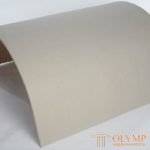 Arched drywall has a thickness of 6.5 mm and is specifically designed for bending. It does not need to be prepared in advance, because it is easily curved in the shape of a semicircle without the application of special effort and without additional devices. This flexibility is achieved due to the presence of fiberglass in the composition of gypsum. However, such material is extremely expensive (twice as expensive as usual), so the masters take a detour and look for a more affordable alternative.
Arched drywall has a thickness of 6.5 mm and is specifically designed for bending. It does not need to be prepared in advance, because it is easily curved in the shape of a semicircle without the application of special effort and without additional devices. This flexibility is achieved due to the presence of fiberglass in the composition of gypsum. However, such material is extremely expensive (twice as expensive as usual), so the masters take a detour and look for a more affordable alternative. We will not consider in detail the process of bending an arched drywall, because there is no wisdom in it. It would be advisable to disassemble other materials in more detail, which were not originally designed for such manipulations.
Choosing a way to bend drywall, first of all, you need to determine for what purpose it is needed. In various situations, you will need to obtain material of different degrees of curvature.

Decorative elements in the interior
Rectangular forms in the room have long been outdated and are not the best design solutions. To make the apartment really original and modern, in the interiors are often added curly elements. These are not only traditional arched openings, which everyone has become accustomed to, but also more interesting ideas from designers.
Bending drywall need along, not across.
Already the classic forms have already become smooth forms on the ceiling, which give it sophistication. Interior partitions simply must have rounded elements to look aesthetically pleasing. Often, with the help of curved drywall podiums are created. Convex and concave structures can be used in any part of the apartment.
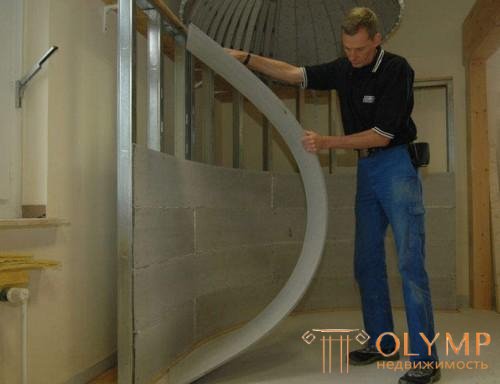
Bend drywall can effortlessly
All or part of the sheet can be bent by simple mechanical action. There is nothing difficult in this, since drywall can be bent dry by applying a minimum of effort. If you overdo it, the material will simply crack. Obviously, this method is good only in those cases when it comes to smooth lines and slight bending. The radius of possible bending is directly dependent on the thickness of the sheet.
| Drywall Bending Radius Table | ||
| Sheet thickness | Minimum radius of a dry bend | Wet Bend Min Radius |
| 6.5 mm | 100 cm | 30 cm |
| 8 mm | 155 cm | 38 cm |
| 9.5 mm | 200 cm | 50 cm |
| 12.5 mm | 275 cm | 100 cm |
The table shows that the possibilities of the dry method are not as extensive as that of the “wet” one (let's talk about it a bit later). So how to bend on dry?
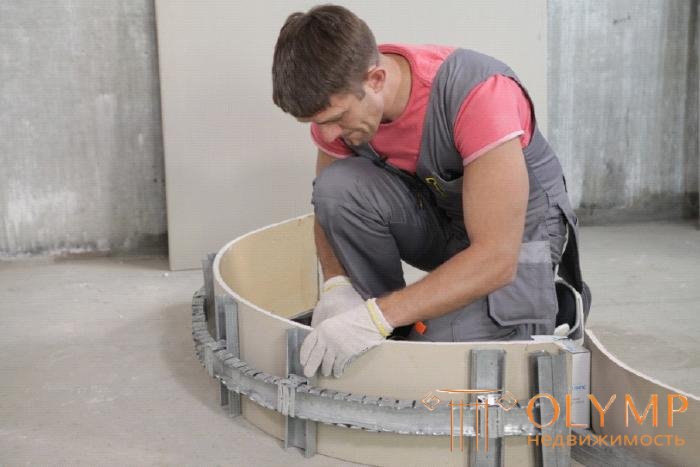
Gradually bending, we attach the drywall to the frame
In this position, the material is left for a day, and then removed. The form given to drywall will not go anywhere, and the sheet can be used for its intended purpose.
Before you bend drywall by this method, you need to make sure that the resulting radius is within acceptable limits, and nothing will crack in the process.
The created frame can be either small in shape (for thin strips) or it can be impressive in size so that the whole sheet can be bent.
There are two options for bending drywall using wetting materials. Consider the simplest of them, which is used in cases where you need to bend a strip of drywall of a small width.
HL strip wetted with a damp sponge on one side. Under the influence of moisture, the cardboard will soften, and will pass water to the core. The gypsum itself is sufficiently porous to begin to absorb this moisture, and as a result it will become soft and pliable from solid.
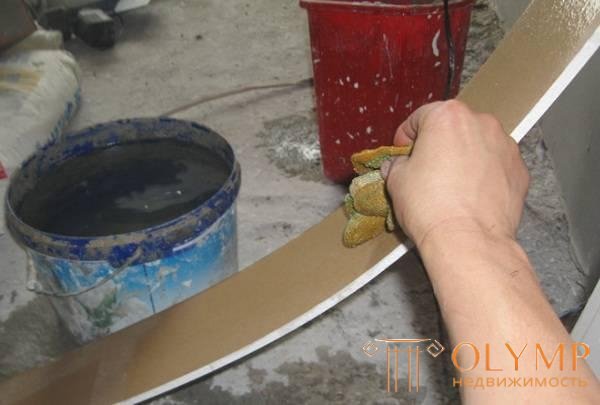
We wet a strip of drywall with a sponge
The strip should be given the desired shape and fixed in this position. When the moisture evaporates, the gypsum will dry out and become hard again, so that the strip will acquire a new shape. Care should be taken that the wet side is concave and the dry side is convex.
This option is well suited for thin strips and small bends. If a more convex structure is required or you need to work with a whole sheet, then this method will not work.
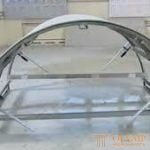 This method is considered the most effective and gives the possibility of bending GCR almost to any form. Before bending the drywall in a semicircle, you will need to get one simple device. This is a special needle roller. His needles will be used to perforate the gypsum plaster to improve water absorption and reduce the likelihood that the sheet may crack. A lot of punctures will also make the cardboard more pliable.
This method is considered the most effective and gives the possibility of bending GCR almost to any form. Before bending the drywall in a semicircle, you will need to get one simple device. This is a special needle roller. His needles will be used to perforate the gypsum plaster to improve water absorption and reduce the likelihood that the sheet may crack. A lot of punctures will also make the cardboard more pliable.
The length of the needles of the roller should be between 1/3 and 1/2 of the thickness of the sheet. Otherwise, the perforation will be useless, and either the water will not be able to be absorbed normally, or the plaster core of the sheet will be destroyed.
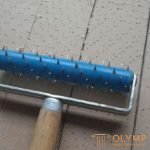 A needle roller makes wiring around the perimeter of the sheet to leave small holes. In the absence of a roller, you can use an awl, but it will take much more time and effort.
A needle roller makes wiring around the perimeter of the sheet to leave small holes. In the absence of a roller, you can use an awl, but it will take much more time and effort. About a day later, the drywall is completely dry, after which it can no longer be curved without the risk of damage.
Answering a question about how to bend drywall, another interesting method should be mentioned. The truth is that when it is used, drywall is cracked, so this is not quite a bending of the sheet in the usual sense.
From the back of the sheet with a sharp knife you need to make parallel cuts with an interval of 1-5 cm. At the same time, the knife should pass through the layer of gypsum to the cardboard from the back side, but not cut it. The distance between the cuts directly depends on the desired bend radius. The smaller the radius, the smaller the step between the cuts, and vice versa. As a result, we get drywall, which is cut on the one hand, but keeps together, thanks to a single layer of cardboard on the other side.
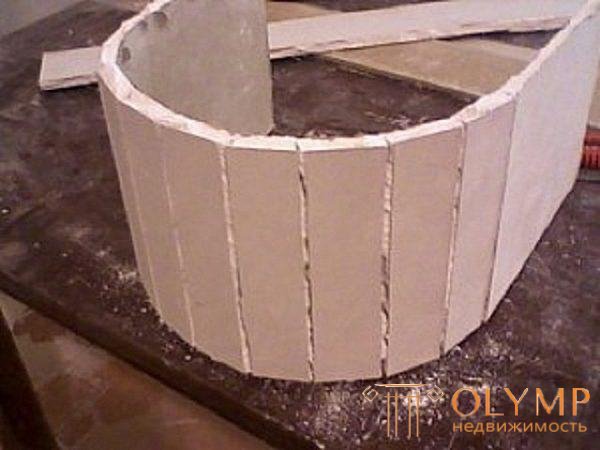
When cutting drywall, it is important that one side remains solid.
The resulting harmonica is attached to the profile on the wall or ceiling so that the desired arc, semicircle or other intended figure is obtained. With self-tapping screws it is necessary to fix each notched piece of drywall so that it does not dangle in the future, and a solid construction is obtained.
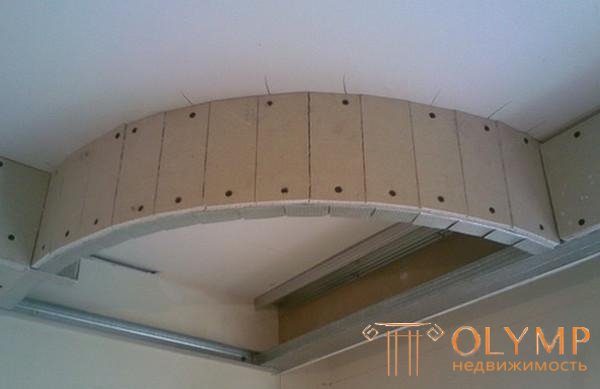
The incised drywall is attached to the frame with self-tapping screws
If the GKL piece is too large, then the master will need the help of a partner to attach it. One will support the material so that it does not break, and the other will be able to securely fix it.
It should be noted that after such installation there are many slots that will have to be carefully putty. If you do everything right, then visually it will seem that the drywall was bent and not cut into pieces.
Что бы оставить комментарий войдите
Комментарии (0)